Human Resources Management in Shell Canada Limited
VerifiedAdded on 2023/06/15
|10
|2035
|407
AI Summary
This report identifies the human resource issues in Shell Canada Limited, which is a subsidiary of Royal Dutch Shell. The report suggests training programs to increase employee engagement, manage diversity, and provide different skills to the employees.
Contribute Materials
Your contribution can guide someone’s learning journey. Share your
documents today.
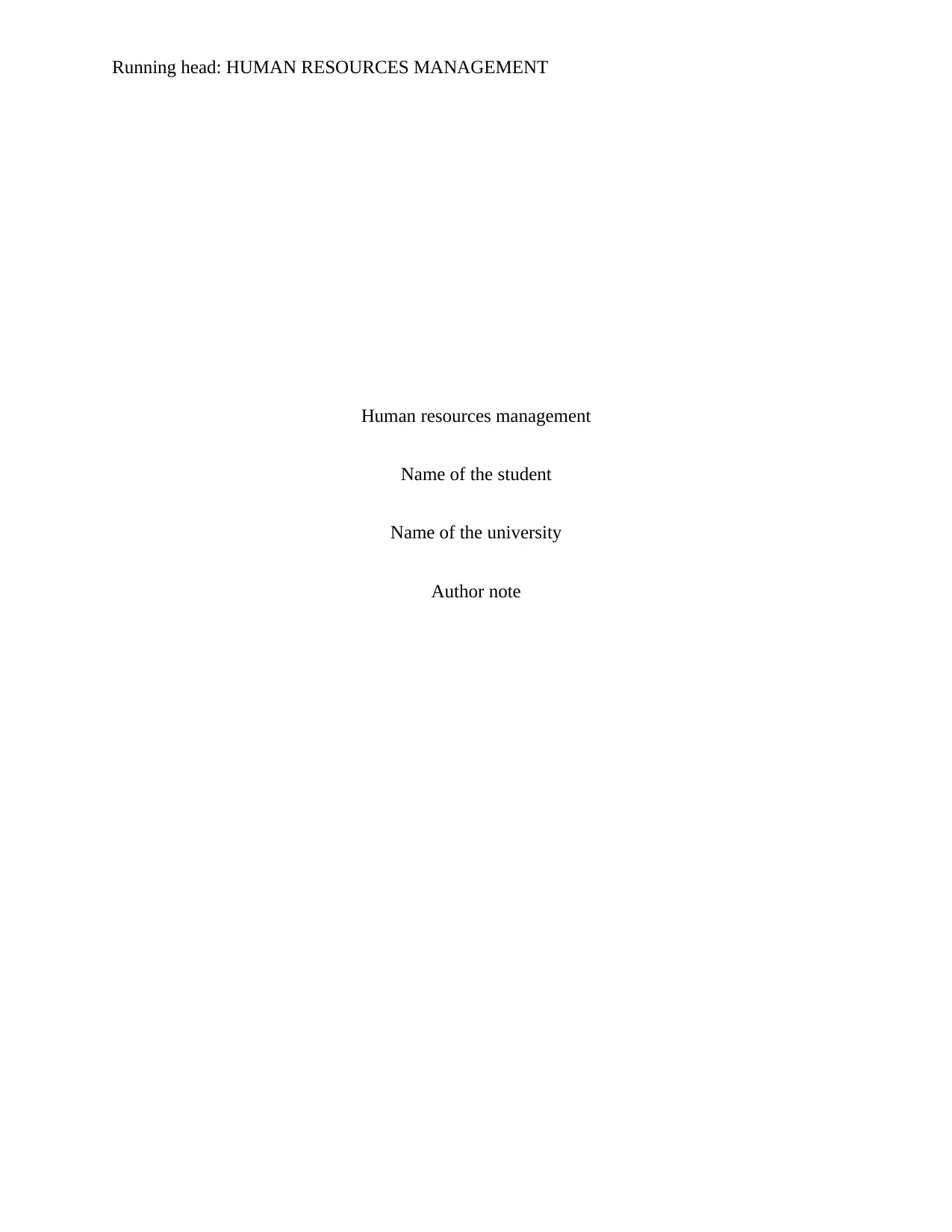
Running head: HUMAN RESOURCES MANAGEMENT
Human resources management
Name of the student
Name of the university
Author note
Human resources management
Name of the student
Name of the university
Author note
Secure Best Marks with AI Grader
Need help grading? Try our AI Grader for instant feedback on your assignments.
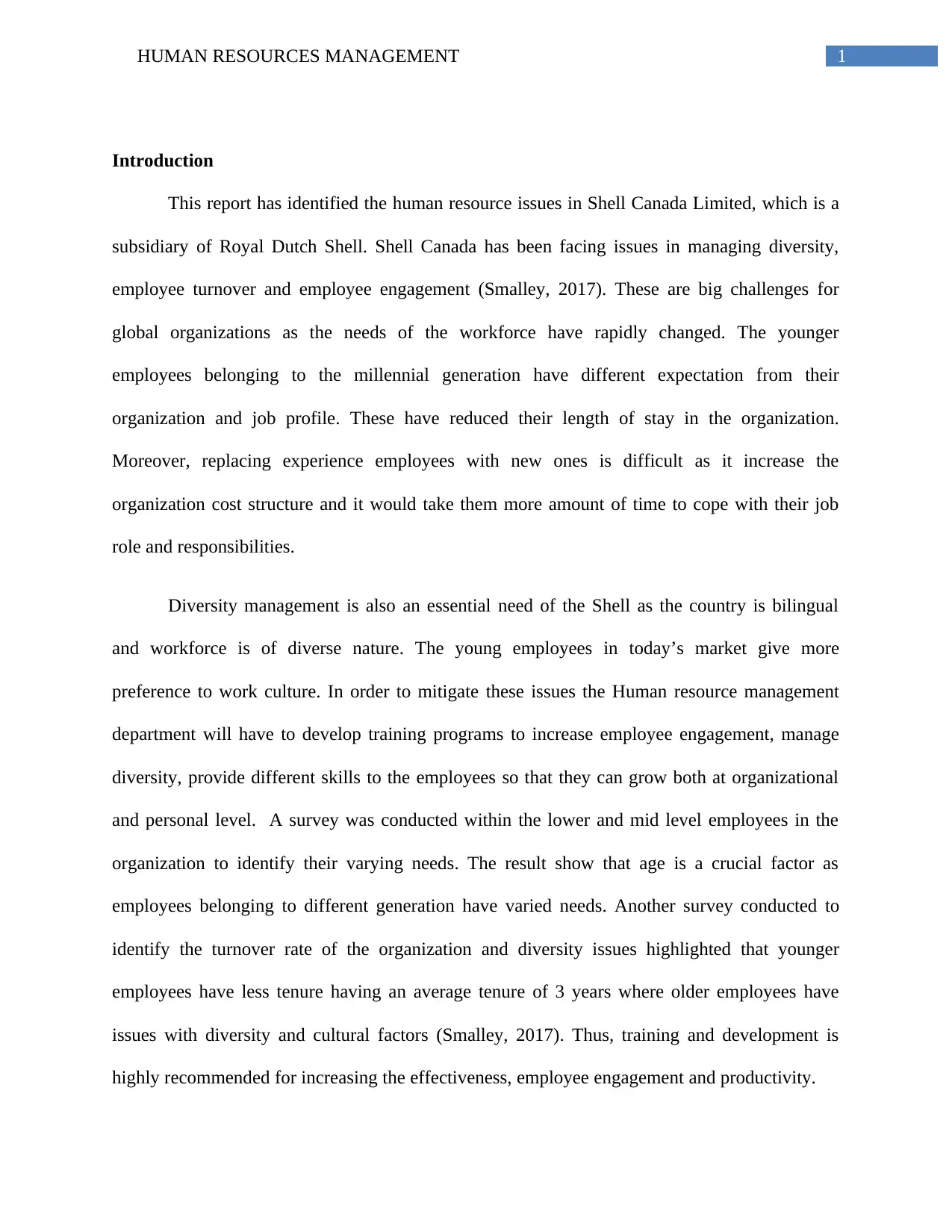
1HUMAN RESOURCES MANAGEMENT
Introduction
This report has identified the human resource issues in Shell Canada Limited, which is a
subsidiary of Royal Dutch Shell. Shell Canada has been facing issues in managing diversity,
employee turnover and employee engagement (Smalley, 2017). These are big challenges for
global organizations as the needs of the workforce have rapidly changed. The younger
employees belonging to the millennial generation have different expectation from their
organization and job profile. These have reduced their length of stay in the organization.
Moreover, replacing experience employees with new ones is difficult as it increase the
organization cost structure and it would take them more amount of time to cope with their job
role and responsibilities.
Diversity management is also an essential need of the Shell as the country is bilingual
and workforce is of diverse nature. The young employees in today’s market give more
preference to work culture. In order to mitigate these issues the Human resource management
department will have to develop training programs to increase employee engagement, manage
diversity, provide different skills to the employees so that they can grow both at organizational
and personal level. A survey was conducted within the lower and mid level employees in the
organization to identify their varying needs. The result show that age is a crucial factor as
employees belonging to different generation have varied needs. Another survey conducted to
identify the turnover rate of the organization and diversity issues highlighted that younger
employees have less tenure having an average tenure of 3 years where older employees have
issues with diversity and cultural factors (Smalley, 2017). Thus, training and development is
highly recommended for increasing the effectiveness, employee engagement and productivity.
Introduction
This report has identified the human resource issues in Shell Canada Limited, which is a
subsidiary of Royal Dutch Shell. Shell Canada has been facing issues in managing diversity,
employee turnover and employee engagement (Smalley, 2017). These are big challenges for
global organizations as the needs of the workforce have rapidly changed. The younger
employees belonging to the millennial generation have different expectation from their
organization and job profile. These have reduced their length of stay in the organization.
Moreover, replacing experience employees with new ones is difficult as it increase the
organization cost structure and it would take them more amount of time to cope with their job
role and responsibilities.
Diversity management is also an essential need of the Shell as the country is bilingual
and workforce is of diverse nature. The young employees in today’s market give more
preference to work culture. In order to mitigate these issues the Human resource management
department will have to develop training programs to increase employee engagement, manage
diversity, provide different skills to the employees so that they can grow both at organizational
and personal level. A survey was conducted within the lower and mid level employees in the
organization to identify their varying needs. The result show that age is a crucial factor as
employees belonging to different generation have varied needs. Another survey conducted to
identify the turnover rate of the organization and diversity issues highlighted that younger
employees have less tenure having an average tenure of 3 years where older employees have
issues with diversity and cultural factors (Smalley, 2017). Thus, training and development is
highly recommended for increasing the effectiveness, employee engagement and productivity.
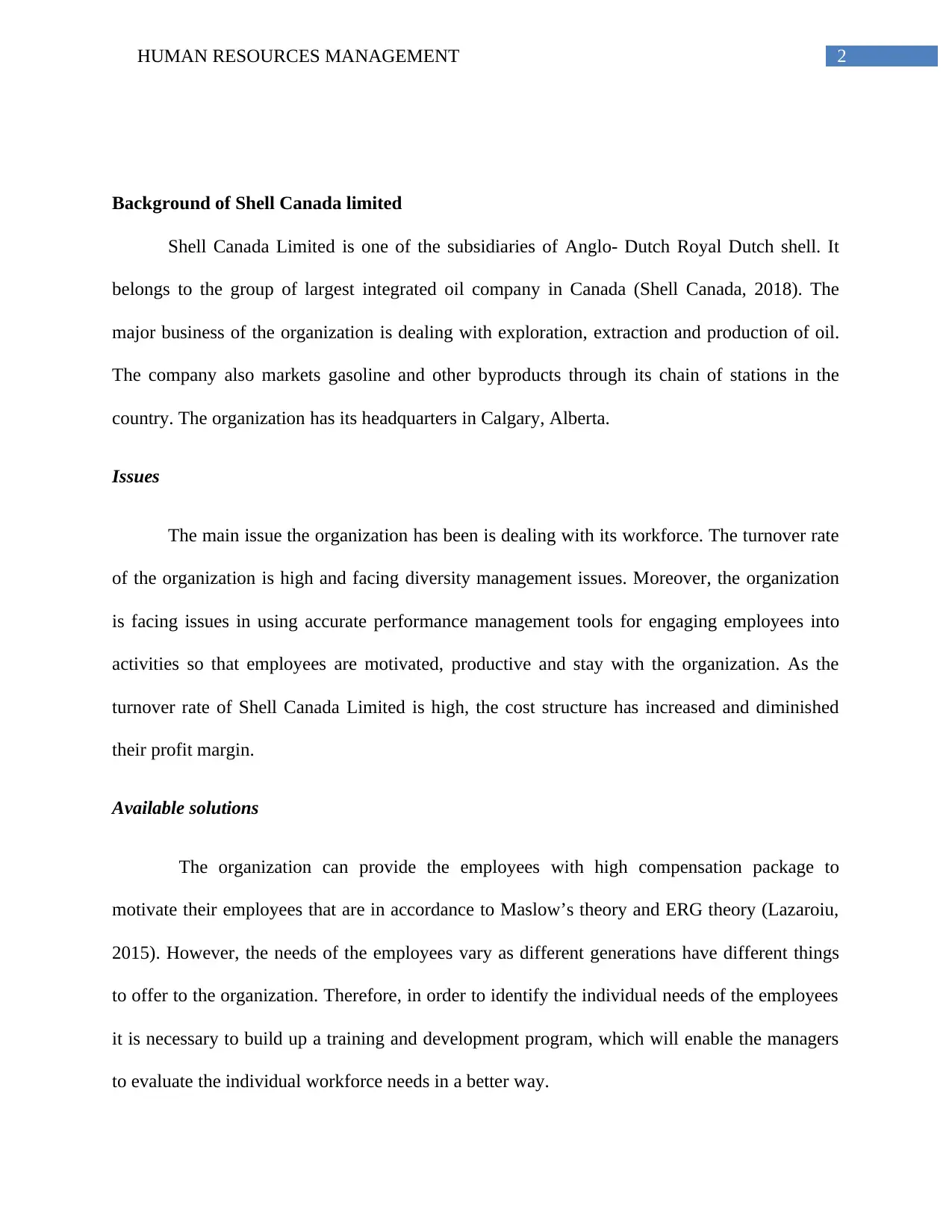
2HUMAN RESOURCES MANAGEMENT
Background of Shell Canada limited
Shell Canada Limited is one of the subsidiaries of Anglo- Dutch Royal Dutch shell. It
belongs to the group of largest integrated oil company in Canada (Shell Canada, 2018). The
major business of the organization is dealing with exploration, extraction and production of oil.
The company also markets gasoline and other byproducts through its chain of stations in the
country. The organization has its headquarters in Calgary, Alberta.
Issues
The main issue the organization has been is dealing with its workforce. The turnover rate
of the organization is high and facing diversity management issues. Moreover, the organization
is facing issues in using accurate performance management tools for engaging employees into
activities so that employees are motivated, productive and stay with the organization. As the
turnover rate of Shell Canada Limited is high, the cost structure has increased and diminished
their profit margin.
Available solutions
The organization can provide the employees with high compensation package to
motivate their employees that are in accordance to Maslow’s theory and ERG theory (Lazaroiu,
2015). However, the needs of the employees vary as different generations have different things
to offer to the organization. Therefore, in order to identify the individual needs of the employees
it is necessary to build up a training and development program, which will enable the managers
to evaluate the individual workforce needs in a better way.
Background of Shell Canada limited
Shell Canada Limited is one of the subsidiaries of Anglo- Dutch Royal Dutch shell. It
belongs to the group of largest integrated oil company in Canada (Shell Canada, 2018). The
major business of the organization is dealing with exploration, extraction and production of oil.
The company also markets gasoline and other byproducts through its chain of stations in the
country. The organization has its headquarters in Calgary, Alberta.
Issues
The main issue the organization has been is dealing with its workforce. The turnover rate
of the organization is high and facing diversity management issues. Moreover, the organization
is facing issues in using accurate performance management tools for engaging employees into
activities so that employees are motivated, productive and stay with the organization. As the
turnover rate of Shell Canada Limited is high, the cost structure has increased and diminished
their profit margin.
Available solutions
The organization can provide the employees with high compensation package to
motivate their employees that are in accordance to Maslow’s theory and ERG theory (Lazaroiu,
2015). However, the needs of the employees vary as different generations have different things
to offer to the organization. Therefore, in order to identify the individual needs of the employees
it is necessary to build up a training and development program, which will enable the managers
to evaluate the individual workforce needs in a better way.
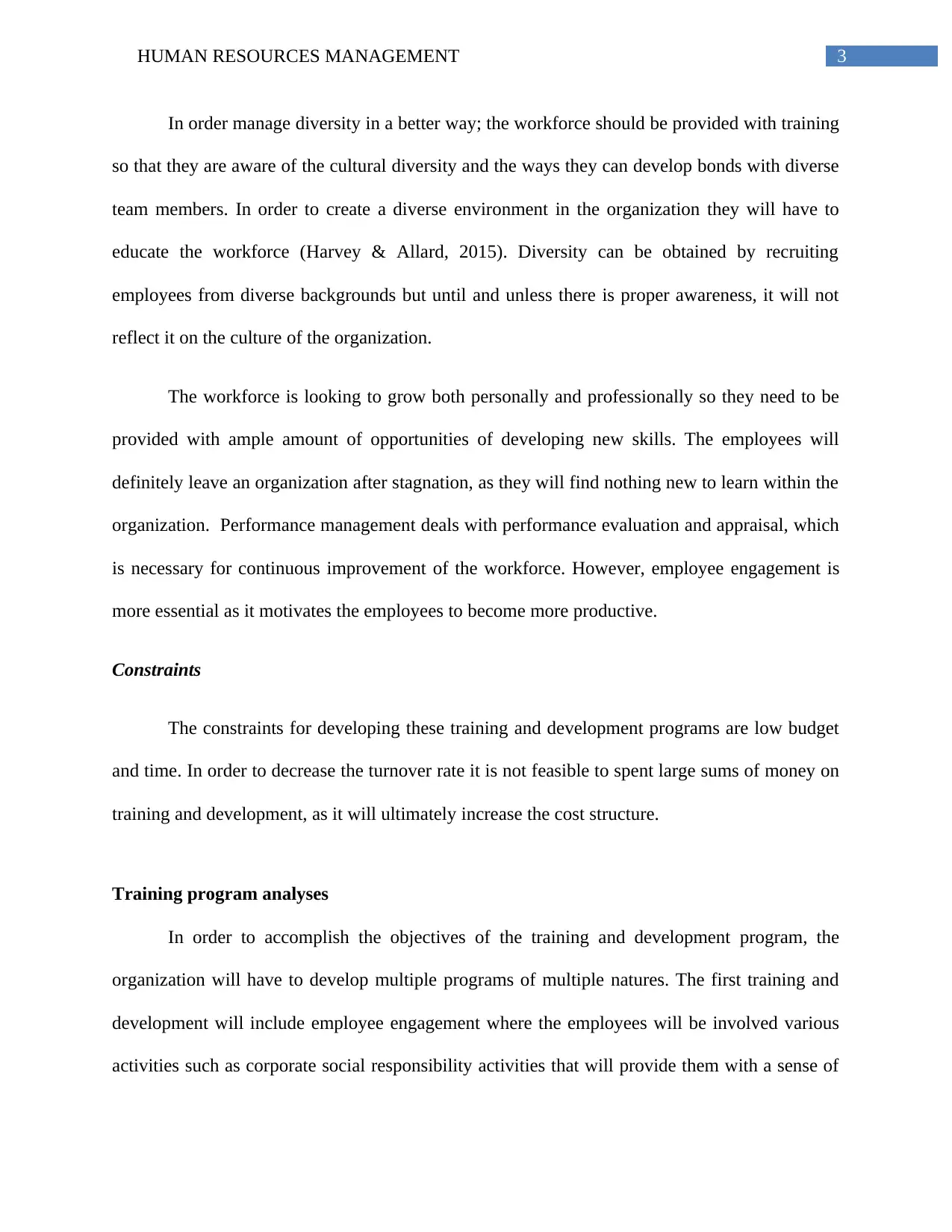
3HUMAN RESOURCES MANAGEMENT
In order manage diversity in a better way; the workforce should be provided with training
so that they are aware of the cultural diversity and the ways they can develop bonds with diverse
team members. In order to create a diverse environment in the organization they will have to
educate the workforce (Harvey & Allard, 2015). Diversity can be obtained by recruiting
employees from diverse backgrounds but until and unless there is proper awareness, it will not
reflect it on the culture of the organization.
The workforce is looking to grow both personally and professionally so they need to be
provided with ample amount of opportunities of developing new skills. The employees will
definitely leave an organization after stagnation, as they will find nothing new to learn within the
organization. Performance management deals with performance evaluation and appraisal, which
is necessary for continuous improvement of the workforce. However, employee engagement is
more essential as it motivates the employees to become more productive.
Constraints
The constraints for developing these training and development programs are low budget
and time. In order to decrease the turnover rate it is not feasible to spent large sums of money on
training and development, as it will ultimately increase the cost structure.
Training program analyses
In order to accomplish the objectives of the training and development program, the
organization will have to develop multiple programs of multiple natures. The first training and
development will include employee engagement where the employees will be involved various
activities such as corporate social responsibility activities that will provide them with a sense of
In order manage diversity in a better way; the workforce should be provided with training
so that they are aware of the cultural diversity and the ways they can develop bonds with diverse
team members. In order to create a diverse environment in the organization they will have to
educate the workforce (Harvey & Allard, 2015). Diversity can be obtained by recruiting
employees from diverse backgrounds but until and unless there is proper awareness, it will not
reflect it on the culture of the organization.
The workforce is looking to grow both personally and professionally so they need to be
provided with ample amount of opportunities of developing new skills. The employees will
definitely leave an organization after stagnation, as they will find nothing new to learn within the
organization. Performance management deals with performance evaluation and appraisal, which
is necessary for continuous improvement of the workforce. However, employee engagement is
more essential as it motivates the employees to become more productive.
Constraints
The constraints for developing these training and development programs are low budget
and time. In order to decrease the turnover rate it is not feasible to spent large sums of money on
training and development, as it will ultimately increase the cost structure.
Training program analyses
In order to accomplish the objectives of the training and development program, the
organization will have to develop multiple programs of multiple natures. The first training and
development will include employee engagement where the employees will be involved various
activities such as corporate social responsibility activities that will provide them with a sense of
Paraphrase This Document
Need a fresh take? Get an instant paraphrase of this document with our AI Paraphraser
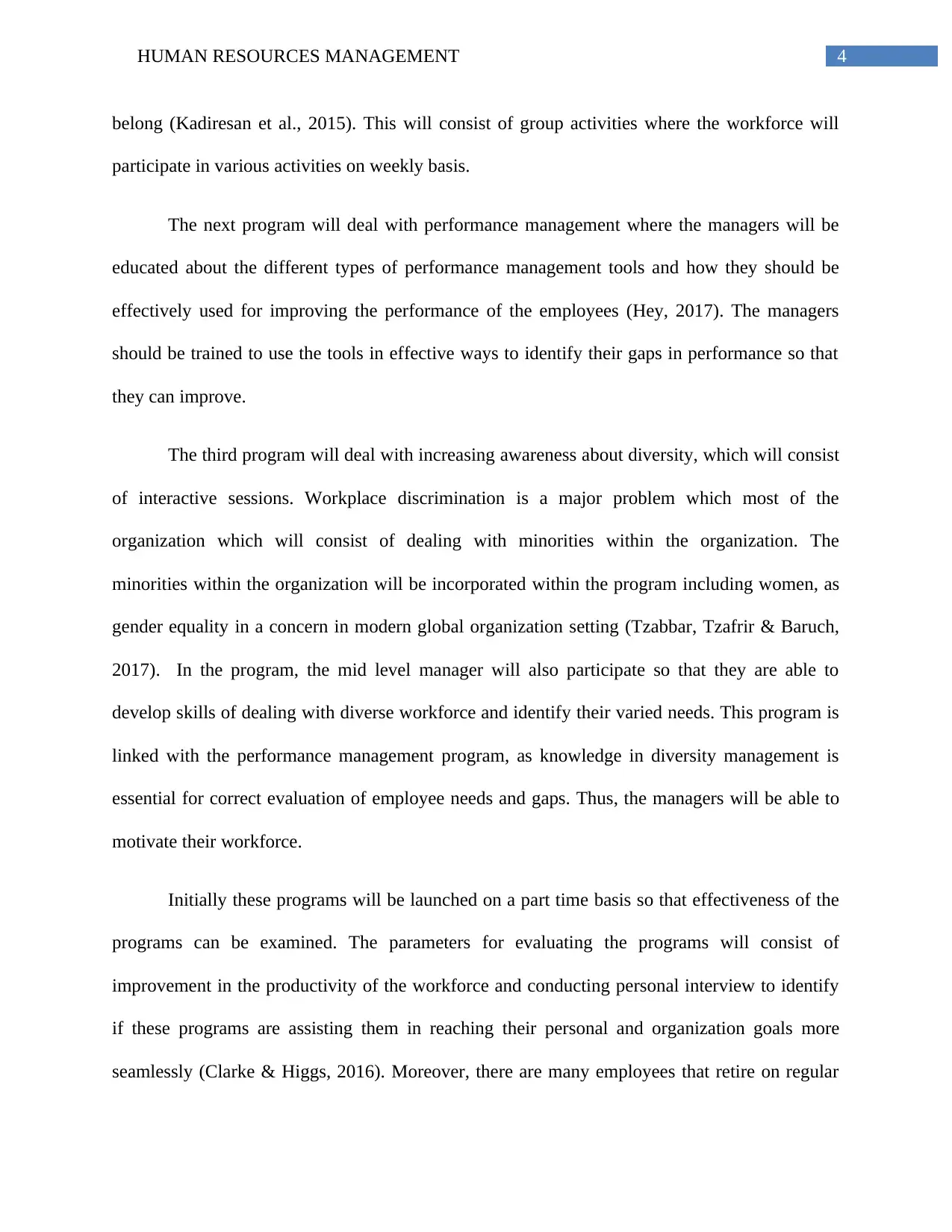
4HUMAN RESOURCES MANAGEMENT
belong (Kadiresan et al., 2015). This will consist of group activities where the workforce will
participate in various activities on weekly basis.
The next program will deal with performance management where the managers will be
educated about the different types of performance management tools and how they should be
effectively used for improving the performance of the employees (Hey, 2017). The managers
should be trained to use the tools in effective ways to identify their gaps in performance so that
they can improve.
The third program will deal with increasing awareness about diversity, which will consist
of interactive sessions. Workplace discrimination is a major problem which most of the
organization which will consist of dealing with minorities within the organization. The
minorities within the organization will be incorporated within the program including women, as
gender equality in a concern in modern global organization setting (Tzabbar, Tzafrir & Baruch,
2017). In the program, the mid level manager will also participate so that they are able to
develop skills of dealing with diverse workforce and identify their varied needs. This program is
linked with the performance management program, as knowledge in diversity management is
essential for correct evaluation of employee needs and gaps. Thus, the managers will be able to
motivate their workforce.
Initially these programs will be launched on a part time basis so that effectiveness of the
programs can be examined. The parameters for evaluating the programs will consist of
improvement in the productivity of the workforce and conducting personal interview to identify
if these programs are assisting them in reaching their personal and organization goals more
seamlessly (Clarke & Higgs, 2016). Moreover, there are many employees that retire on regular
belong (Kadiresan et al., 2015). This will consist of group activities where the workforce will
participate in various activities on weekly basis.
The next program will deal with performance management where the managers will be
educated about the different types of performance management tools and how they should be
effectively used for improving the performance of the employees (Hey, 2017). The managers
should be trained to use the tools in effective ways to identify their gaps in performance so that
they can improve.
The third program will deal with increasing awareness about diversity, which will consist
of interactive sessions. Workplace discrimination is a major problem which most of the
organization which will consist of dealing with minorities within the organization. The
minorities within the organization will be incorporated within the program including women, as
gender equality in a concern in modern global organization setting (Tzabbar, Tzafrir & Baruch,
2017). In the program, the mid level manager will also participate so that they are able to
develop skills of dealing with diverse workforce and identify their varied needs. This program is
linked with the performance management program, as knowledge in diversity management is
essential for correct evaluation of employee needs and gaps. Thus, the managers will be able to
motivate their workforce.
Initially these programs will be launched on a part time basis so that effectiveness of the
programs can be examined. The parameters for evaluating the programs will consist of
improvement in the productivity of the workforce and conducting personal interview to identify
if these programs are assisting them in reaching their personal and organization goals more
seamlessly (Clarke & Higgs, 2016). Moreover, there are many employees that retire on regular
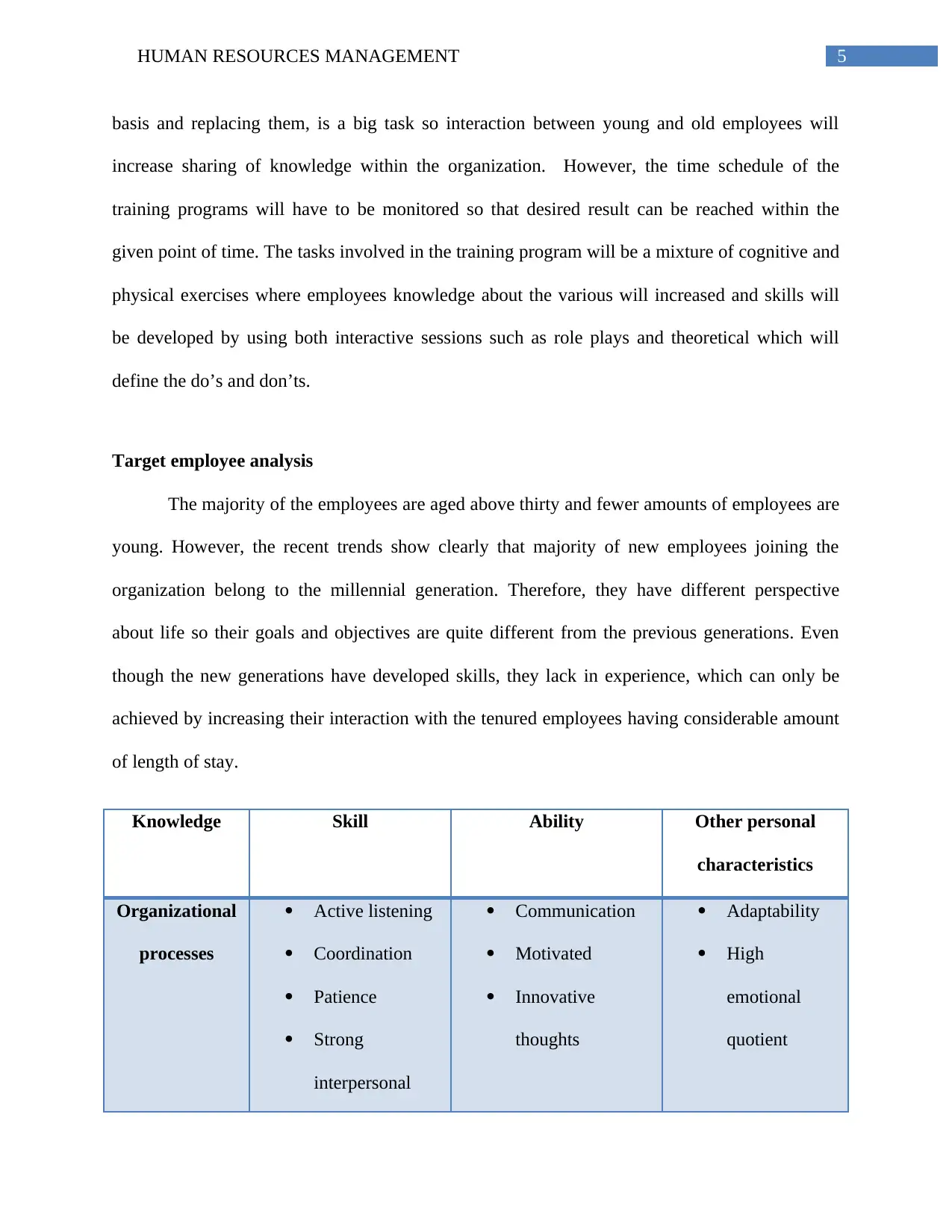
5HUMAN RESOURCES MANAGEMENT
basis and replacing them, is a big task so interaction between young and old employees will
increase sharing of knowledge within the organization. However, the time schedule of the
training programs will have to be monitored so that desired result can be reached within the
given point of time. The tasks involved in the training program will be a mixture of cognitive and
physical exercises where employees knowledge about the various will increased and skills will
be developed by using both interactive sessions such as role plays and theoretical which will
define the do’s and don’ts.
Target employee analysis
The majority of the employees are aged above thirty and fewer amounts of employees are
young. However, the recent trends show clearly that majority of new employees joining the
organization belong to the millennial generation. Therefore, they have different perspective
about life so their goals and objectives are quite different from the previous generations. Even
though the new generations have developed skills, they lack in experience, which can only be
achieved by increasing their interaction with the tenured employees having considerable amount
of length of stay.
Knowledge Skill Ability Other personal
characteristics
Organizational
processes
Active listening
Coordination
Patience
Strong
interpersonal
Communication
Motivated
Innovative
thoughts
Adaptability
High
emotional
quotient
basis and replacing them, is a big task so interaction between young and old employees will
increase sharing of knowledge within the organization. However, the time schedule of the
training programs will have to be monitored so that desired result can be reached within the
given point of time. The tasks involved in the training program will be a mixture of cognitive and
physical exercises where employees knowledge about the various will increased and skills will
be developed by using both interactive sessions such as role plays and theoretical which will
define the do’s and don’ts.
Target employee analysis
The majority of the employees are aged above thirty and fewer amounts of employees are
young. However, the recent trends show clearly that majority of new employees joining the
organization belong to the millennial generation. Therefore, they have different perspective
about life so their goals and objectives are quite different from the previous generations. Even
though the new generations have developed skills, they lack in experience, which can only be
achieved by increasing their interaction with the tenured employees having considerable amount
of length of stay.
Knowledge Skill Ability Other personal
characteristics
Organizational
processes
Active listening
Coordination
Patience
Strong
interpersonal
Communication
Motivated
Innovative
thoughts
Adaptability
High
emotional
quotient
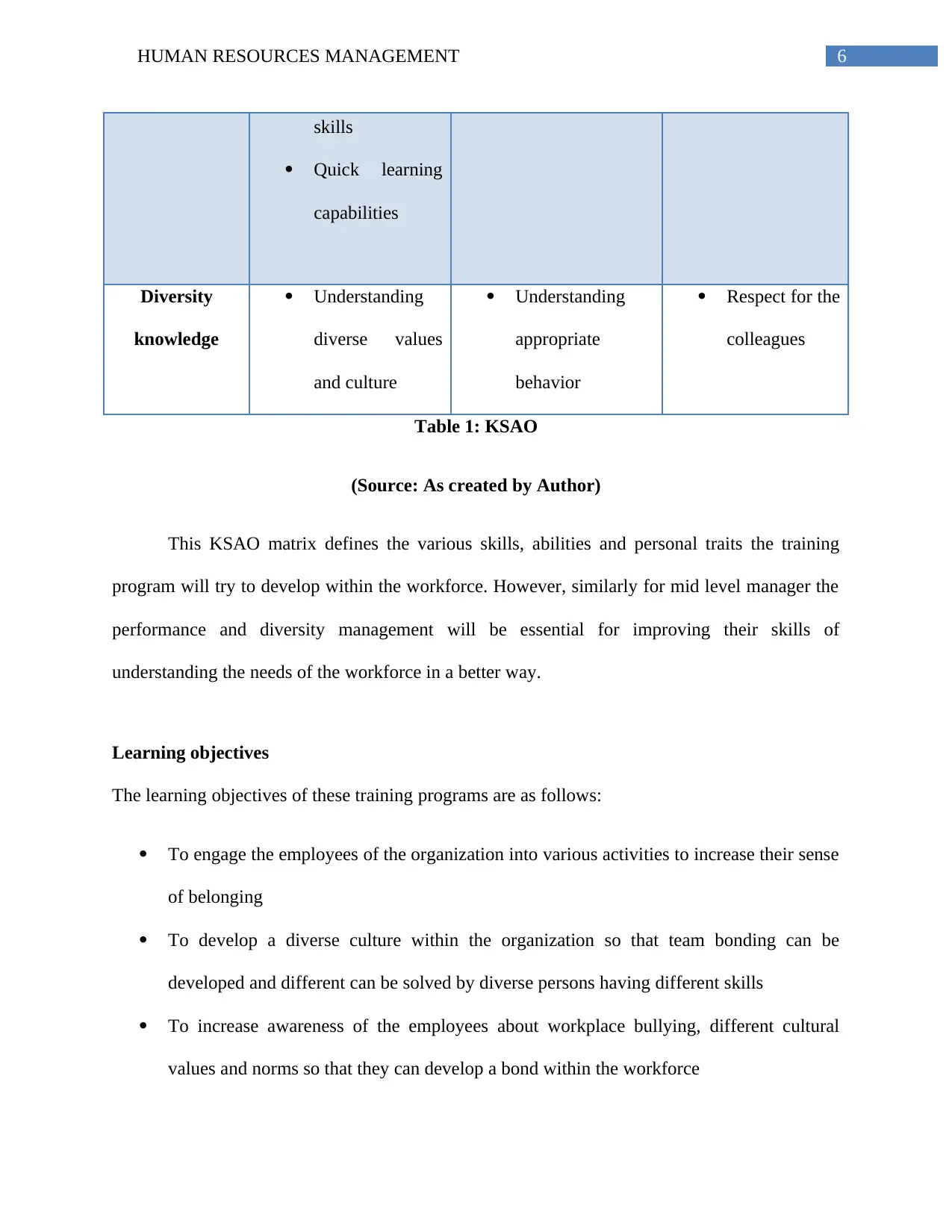
6HUMAN RESOURCES MANAGEMENT
skills
Quick learning
capabilities
Diversity
knowledge
Understanding
diverse values
and culture
Understanding
appropriate
behavior
Respect for the
colleagues
Table 1: KSAO
(Source: As created by Author)
This KSAO matrix defines the various skills, abilities and personal traits the training
program will try to develop within the workforce. However, similarly for mid level manager the
performance and diversity management will be essential for improving their skills of
understanding the needs of the workforce in a better way.
Learning objectives
The learning objectives of these training programs are as follows:
To engage the employees of the organization into various activities to increase their sense
of belonging
To develop a diverse culture within the organization so that team bonding can be
developed and different can be solved by diverse persons having different skills
To increase awareness of the employees about workplace bullying, different cultural
values and norms so that they can develop a bond within the workforce
skills
Quick learning
capabilities
Diversity
knowledge
Understanding
diverse values
and culture
Understanding
appropriate
behavior
Respect for the
colleagues
Table 1: KSAO
(Source: As created by Author)
This KSAO matrix defines the various skills, abilities and personal traits the training
program will try to develop within the workforce. However, similarly for mid level manager the
performance and diversity management will be essential for improving their skills of
understanding the needs of the workforce in a better way.
Learning objectives
The learning objectives of these training programs are as follows:
To engage the employees of the organization into various activities to increase their sense
of belonging
To develop a diverse culture within the organization so that team bonding can be
developed and different can be solved by diverse persons having different skills
To increase awareness of the employees about workplace bullying, different cultural
values and norms so that they can develop a bond within the workforce
Secure Best Marks with AI Grader
Need help grading? Try our AI Grader for instant feedback on your assignments.
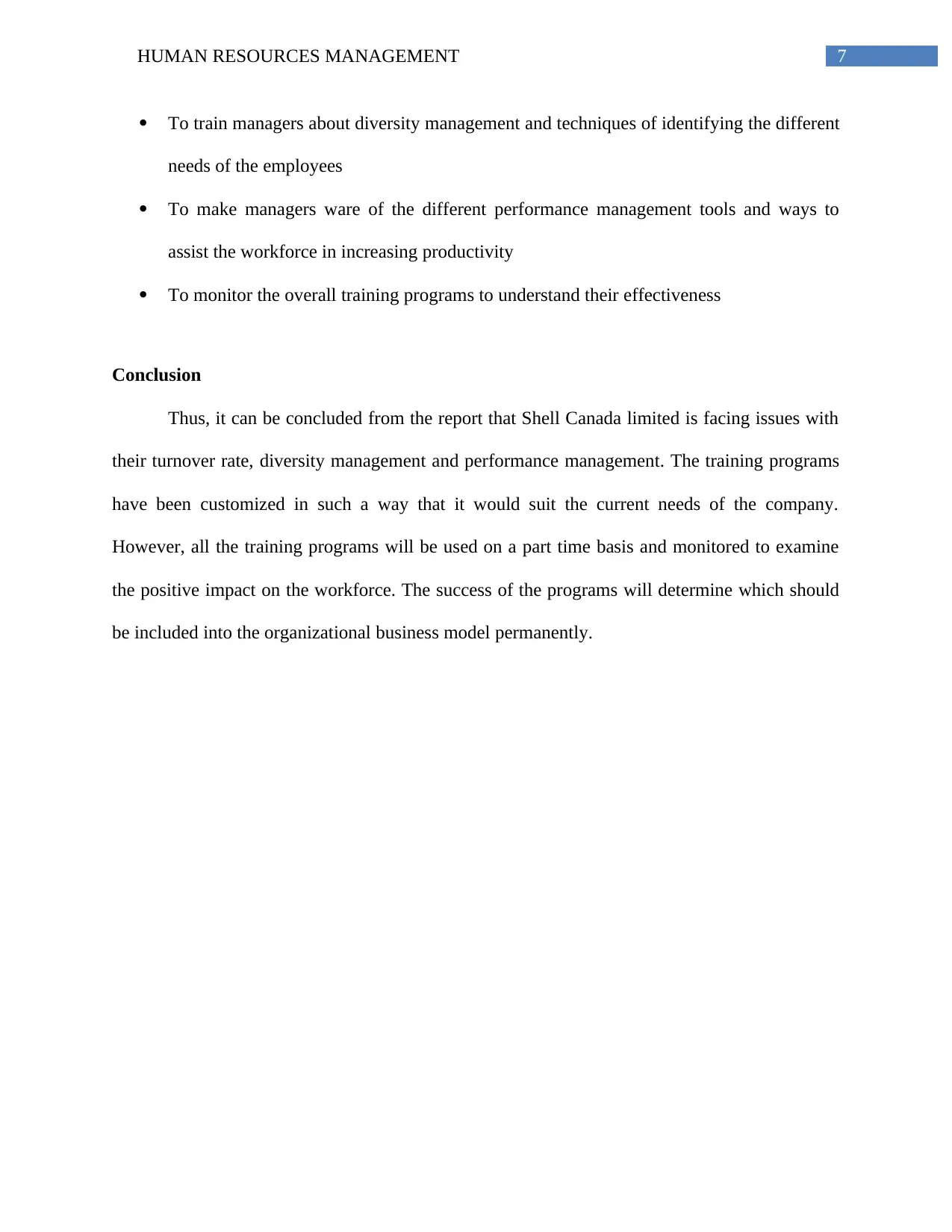
7HUMAN RESOURCES MANAGEMENT
To train managers about diversity management and techniques of identifying the different
needs of the employees
To make managers ware of the different performance management tools and ways to
assist the workforce in increasing productivity
To monitor the overall training programs to understand their effectiveness
Conclusion
Thus, it can be concluded from the report that Shell Canada limited is facing issues with
their turnover rate, diversity management and performance management. The training programs
have been customized in such a way that it would suit the current needs of the company.
However, all the training programs will be used on a part time basis and monitored to examine
the positive impact on the workforce. The success of the programs will determine which should
be included into the organizational business model permanently.
To train managers about diversity management and techniques of identifying the different
needs of the employees
To make managers ware of the different performance management tools and ways to
assist the workforce in increasing productivity
To monitor the overall training programs to understand their effectiveness
Conclusion
Thus, it can be concluded from the report that Shell Canada limited is facing issues with
their turnover rate, diversity management and performance management. The training programs
have been customized in such a way that it would suit the current needs of the company.
However, all the training programs will be used on a part time basis and monitored to examine
the positive impact on the workforce. The success of the programs will determine which should
be included into the organizational business model permanently.

8HUMAN RESOURCES MANAGEMENT
References
Clarke, N., & Higgs, M. (2016). How strategic focus relates to the delivery of leadership training
and development. Human Resource Management, 55(4), 541-565.
Harvey, C. P., & Allard, M. (2015). Understanding and managing diversity: Readings, cases,
and exercises. Pearson.
Hey, R. B. (2017). Performance Management for the Oil, Gas, and Process Industries: A
Systems Approach. Gulf Professional Publishing.
Kadiresan, V., Selamat, M. H., Selladurai, S., SPR, C. R., & Mohamed, R. K. M. H. (2015).
Performance appraisal and training and development of human resource management
practices (HRM) on organizational commitment and turnover intention. Asian Social
Science, 11(24), 162.
Lazaroiu, G. (2015). Employee motivation and job performance. Linguistic and Philosophical
Investigations, 14, 97.
Shell Canada. (2018). Shell Canada. Shell.ca. Retrieved 13 February 2018, from
https://www.shell.ca/
Smalley, K. (2017). Top HR challenges of 2017 | Randstad Canada. Randstad.ca. Retrieved 13
February 2018, from https://www.randstad.ca/workforce360-trends/archives/top-hr-
challenges-of-2017_601/
Tzabbar, D., Tzafrir, S., & Baruch, Y. (2017). A bridge over troubled water: Replication,
integration and extension of the relationship between HRM practices and organizational
References
Clarke, N., & Higgs, M. (2016). How strategic focus relates to the delivery of leadership training
and development. Human Resource Management, 55(4), 541-565.
Harvey, C. P., & Allard, M. (2015). Understanding and managing diversity: Readings, cases,
and exercises. Pearson.
Hey, R. B. (2017). Performance Management for the Oil, Gas, and Process Industries: A
Systems Approach. Gulf Professional Publishing.
Kadiresan, V., Selamat, M. H., Selladurai, S., SPR, C. R., & Mohamed, R. K. M. H. (2015).
Performance appraisal and training and development of human resource management
practices (HRM) on organizational commitment and turnover intention. Asian Social
Science, 11(24), 162.
Lazaroiu, G. (2015). Employee motivation and job performance. Linguistic and Philosophical
Investigations, 14, 97.
Shell Canada. (2018). Shell Canada. Shell.ca. Retrieved 13 February 2018, from
https://www.shell.ca/
Smalley, K. (2017). Top HR challenges of 2017 | Randstad Canada. Randstad.ca. Retrieved 13
February 2018, from https://www.randstad.ca/workforce360-trends/archives/top-hr-
challenges-of-2017_601/
Tzabbar, D., Tzafrir, S., & Baruch, Y. (2017). A bridge over troubled water: Replication,
integration and extension of the relationship between HRM practices and organizational
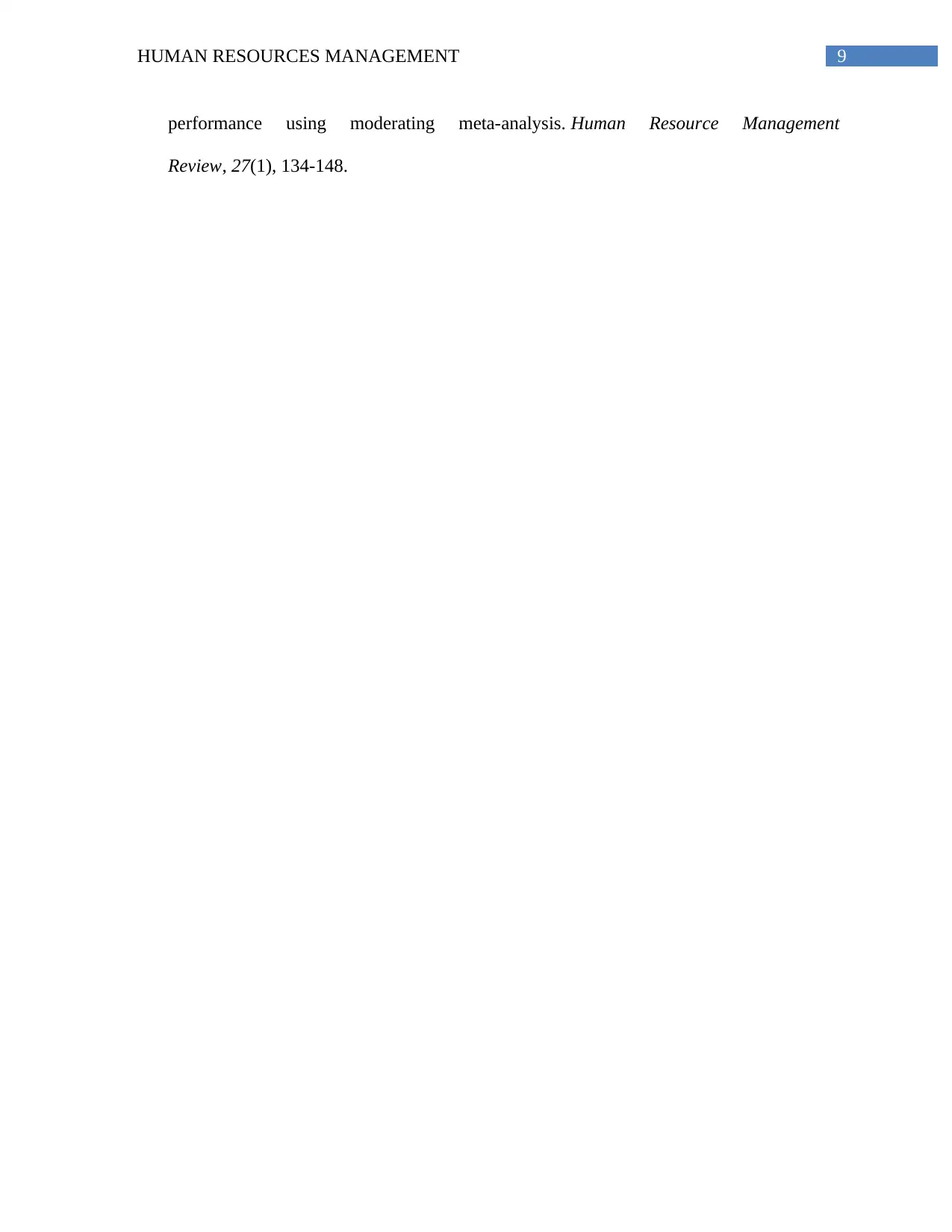
9HUMAN RESOURCES MANAGEMENT
performance using moderating meta-analysis. Human Resource Management
Review, 27(1), 134-148.
performance using moderating meta-analysis. Human Resource Management
Review, 27(1), 134-148.
1 out of 10
![[object Object]](/_next/static/media/star-bottom.7253800d.svg)





